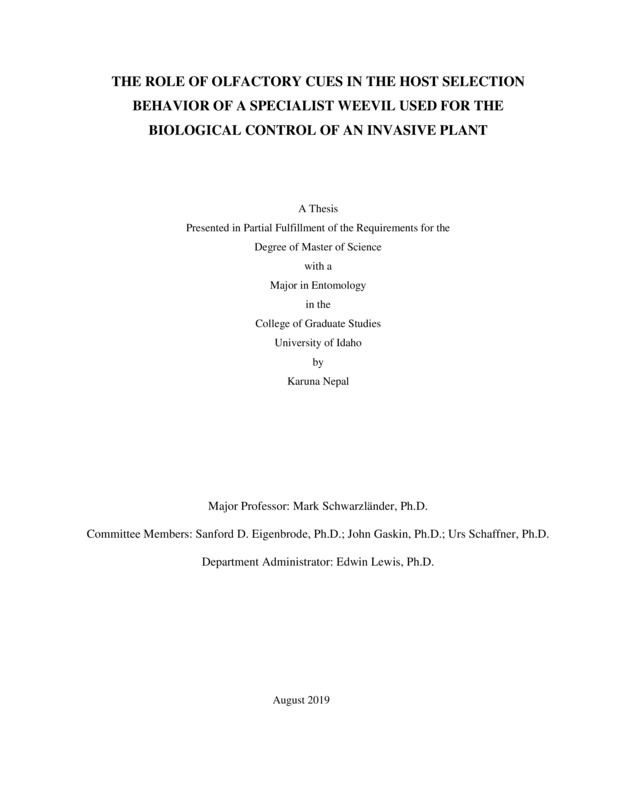HOST SELECTION BEHAVIOR IN A SPECIALIST WEEVIL USED FOR BIOLOGICAL CONTROL OF AN INVASIVE PLANT USING OLFACTORY CUES
Nepal, Karuna. (2019-08). HOST SELECTION BEHAVIOR IN A SPECIALIST WEEVIL USED FOR BIOLOGICAL CONTROL OF AN INVASIVE PLANT USING OLFACTORY CUES. Theses and Dissertations Collection, University of Idaho Library Digital Collections. https://www.lib.uidaho.edu/digital/etd/items/nepal_idaho_0089n_11671.html
- Title:
- HOST SELECTION BEHAVIOR IN A SPECIALIST WEEVIL USED FOR BIOLOGICAL CONTROL OF AN INVASIVE PLANT USING OLFACTORY CUES
- Author:
- Nepal, Karuna
- Date:
- 2019-08
- Program:
- Plant, Soil and Entomological Sciences
- Subject Category:
- Entomology
- Abstract:
-
Mogulones crucifer Pallas (Coleoptera: Curculionidae), root miner, was released in Canada in 1997 for the biological control of the invasive plant Cynoglossum officinale L. (Boraginaceae). Release of this weevil in the United States was not permitted due to concerns on potential confamilial non-target attack on Federally listed threatened and endangered plant species. For environmental safety assessment of this weevil to native Boraginaceae plant species: 1) Assessed the behavioral responses to olfactory cues weevil to the cues of C. officinale and selected Eurasian confamilial plants and electrophysiological experiments (GC-EAD) to assess antennal responses of M. crucifer and characterized the headspace volatile profiles of tested plant species (GC/MS) 2) Assessed the behavioral responses to olfactory cues C. officinale and selected North American confamilial plants and electrophysiological experiments (GC-EAD) to assess antennal responses of weevil and characterized the headspace volatile profiles of tested plant species (GC/MS). M. crucifer strongly preferred its field host C. officinale over all tested non-target plants. Among non-target plants Hackelia micrantha shared the greatest number of compounds with C. officinale whereas Oreocarya rugulosa, Oreocarya celosioides and Rindera umbellata shared least. In addition, I identified six electrophysiologically active compounds in C. officinale, five electrophysiologically active compounds in H. micrantha and four electrophysiologically active compounds in O. crassipes. Results from these experiments suggest M. crucifer can locate its host plant and avoid non-target plant species.
- Description:
- masters, M.S., Plant, Soil and Entomological Sciences -- University of Idaho - College of Graduate Studies, 2019-08
- Major Professor:
- Schwarzlaender, Mark
- Committee:
- Eigenbrode, Sanford D.; Schaffner, Urs; Gaskin, John
- Defense Date:
- 2019-08
- Identifier:
- Nepal_idaho_0089N_11671
- Type:
- Text
- Format Original:
- Format:
- application/pdf
- Rights:
- In Copyright - Educational Use Permitted. For more information, please contact University of Idaho Library Special Collections and Archives Department at libspec@uidaho.edu.
- Standardized Rights:
- http://rightsstatements.org/vocab/InC-EDU/1.0/

